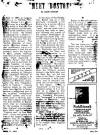Home Page Meet Boston Menu Index
|
MEET BOSTON Friday, April 11, 1941 in What's New In Town W. J. Sidis |

Back in 1841, a runaway slave in Norfolk, Va., named George Latimer, stowed away on a boat at one of the docks in that city. The boat carried him up the coast, and it sailed northward, as he hoped it would. He landed in a strange city―Boston―where he found enough people anxious to give him protection from pursuit. The Norfolk Chamber of Commerce launched threats of dire punishment against Massachusetts if they did not promptly return the fugitive. In reply, protest meetings were held all over Massachusetts, which organized a “Liberty Party,” and which raised funds to purchase the negro’s freedom. A memorial of this event that will go down in history is the poetic speech made at the Ipswich protest meeting by Delegate John Greenleaf of Haverhill. This speech is to be found in all complete collections of Whittier’s poetry under the title “Massachusetts to Virginia.” Freeing fugitive slaves by the boat route from Norfolk to Boston became a recognized part of the so-called “underground railroad” system, and it became such a thriving business that a regular steamship line from Norfolk to Boston, which later on incorporated for the purpose of bringing New England manufacturers down South, and for bringing “Virginia coal” to New England. It has now grown into one of the largest coastwise steamer lines on the Atlantic seacoast of this country, connecting between Boston and a variety of Southern ports.
*
In the days of the Revolution, Boston was on a tiny peninsula, connected with Roxbury by a narrow isthmus called The Neck. This “neck” was not much over a hundred feet wide in spots, and followed the curves of the present Washington St. through the South End. After the “April running battle” (as Holmes calls it), when the British army ran a marathon from Concord into Boston, the minute-men of Roxbury, Dorchester and Milton, hastened to the Neck and stationed themselves in a trench across there from bay to bay thereby bottling up the redcoats and commencing the 11-month siege of Boston. This trench later on became an unofficial road across the neck and, when the filling-in process started in the South Bay, and the Back Bay (on the two sides of the Neck), the road was continued in both directions, and it naturally became one of the main roads of that region. It was a “boulevard” in the true etymological sense, if it is correct, as is stated by that standard Massachusetts product, Webster’s Dictionary, that “boulevard” is a French version of “bulwark,” and originally applied to the roadway left after the fortifications had been taken down. The road is now called Massachusetts Avenue.
*
The Greeks had a word for it. In “[illegible] “the word for a [illegible] was Limen [?]. It is still appropriate enough in its modern New England form, Lynn.
*
Boston is the only metropolis having a continuous chain of parks and parkways interlacing over the entire metropolitan region. The Blue Hills Reservation is the largest single park in any metropolitan area. It is a natural southern portal to Greater Boston.
*
The last horse-car line in Boston was the Marlborough Street line, which ceased operation in 1900. At that time, horse-cars were still prevalent in American cities. The last city to stick to horse-cars was New York, where horse-cars continued in operation till 1916.